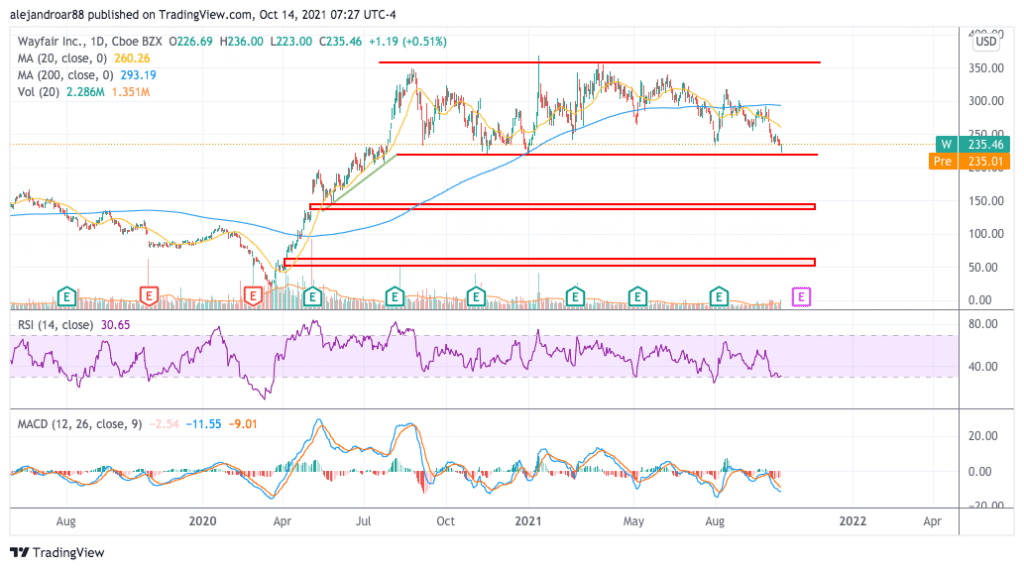Wayfair Stock Down 8% In October – Time to Buy W Stock?
Please note that we are not authorised to provide any investment advice. The content on this page is for information purposes only.
The price of Wayfair stock has been steadily declining in October, shedding a total of 8% of its value to close yesterday at $235.46 per share. Concerns about how supply chain woes could affect the firm’s ability to stock up could be one of the reasons why market participants have progressively disposed of their shares in the American online furniture retailer ahead of the release of its Q3 2021 earnings report.
In late September, Nike (NKE), Bed Bath & Beyond (BBBY), and other retailers made some downbeat comments about how supply chain constraints were affecting their financial outlook for the year as multiple Asian countries are experiencing an uptick in the number of daily cases of the coronavirus.
Could Wayfair’s results be affected by this trend? How is the stock looking ahead of its upcoming earnings release? In the following article, I’ll take a look at the price action and fundamentals of this pandemic winner to outline plausible scenarios for the future.
67% of all retail investor accounts lose money when trading CFDs with this provider.
Wayfair Stock – Technical Analysis

The price of Wayfair stock has been in consolidation mode since August 2020 and was negatively affected by news about Pfizer’s (PFE) vaccine.
For Wayfair, the pandemic has been the strongest tailwind the company has experienced in its history as consumers relied on its online offering to renovate their furniture during lockdowns. As a result, sales exploded 55% higher on a year-on-year basis.
As of yesterday, the stock closed more than 36% below its 52-week high of $369 per share and this decline has led to a third tag of the lower bound of the consolidation rectangle shown in the chart.
Moreover, the price action has also broken below its short-term and long-term moving averages. This indicates the extent of the weakness that the stock is experiencing – possibly as a result of these supply chain concerns.
Trading volumes since the beginning of October have been quite high and they exceeded the 10-day moving average yesterday as well as the price bounced off this important support line.
Momentum oscillators are neck-deep into negative territory with the Relative Strength Index (RSI) currently hovering above oversold levels for the third time since May while the MACD is drifting lower and at a fair distance from the signal line.
Even though the latest price action is quite bearish, how the price behaves upon tagging this $220 horizontal support will likely determine the direction that W stock will take in the future.
A bounce above this threshold could possibly signal that is time for a technical rebound after reaching overly depressed momentum levels while a break below could indicate that weakness will continue.
Wayfair Stock – Fundamental Analysis
For this upcoming third quarter of the year, the consensus estimate for Wayfair’s revenues points to a 15% decline in the firm’s top-line results at $3.3 billion. Meanwhile, adjusted earnings per share are also expected to post a significant decline from $2.30 per share last year to $0.03 per share.
This expected decline in the company’s financial performance could be one of the reasons explaining the latest weakness in the stock price.
Moreover, on a full-year basis, sales of the company are expected to reach a temporary post-pandemic peak to then resume their uptrend in 2022.
From a historical standpoint, sales of Wayfair have grown at a compounded annual growth rate of 43% and are forecasted to move higher at a rate of 18% on average in 2022 and 2023.
Meanwhile, the company’s EBITDA swung to positive territory last year for the first time in the firm’s history at $518 million. Using a range between $500 and $700 million for the firm’s EBITDA for this year based on its forecasted sales and an estimated enterprise value of $25.8 billion, this would result in an EV to EBITDA multiple between 37 and 51.
Data from Statista shows that this range is higher than the average EV-to-EBITDA multiple for online retailers as of 2021 – which is currently standing at 36.
With this in mind, it seems that Wayfair stock could continue to experience a decline even after the company reports its third quarter results it appears to be overvalued from a fundamental perspective.
Moreover, the presence of multiple negative catalysts including a fading pandemic tailwind and supply chain woes may contribute to depressing the firm’s trading multiples and this magnifies the downside risks for Wayfair stock.






